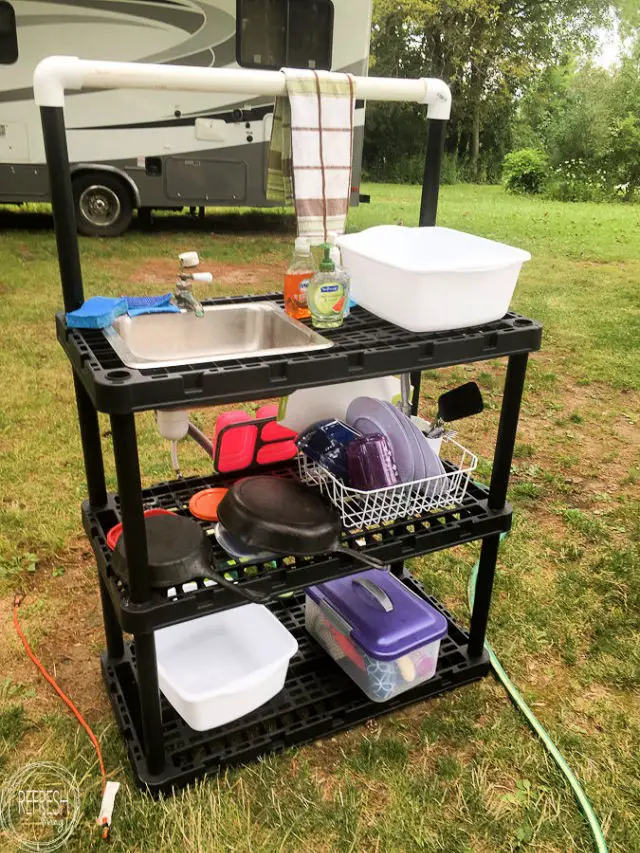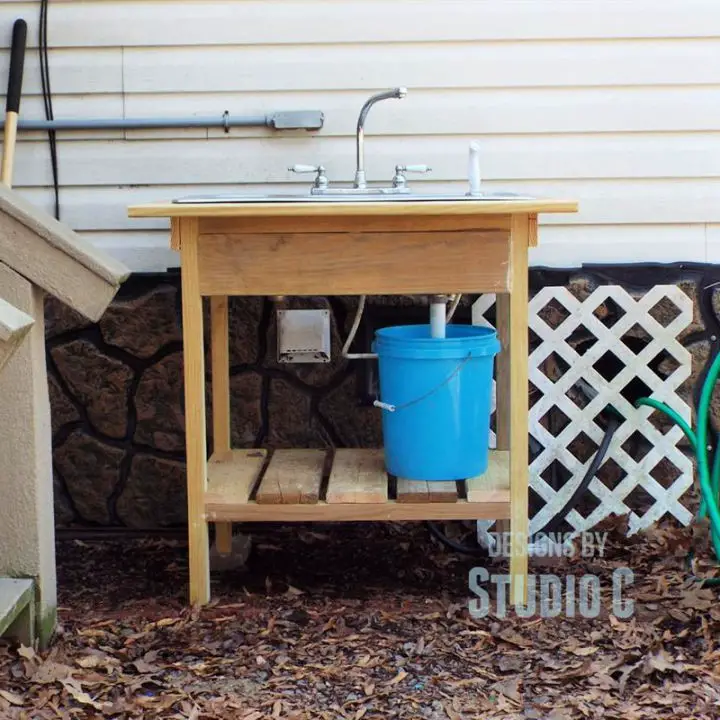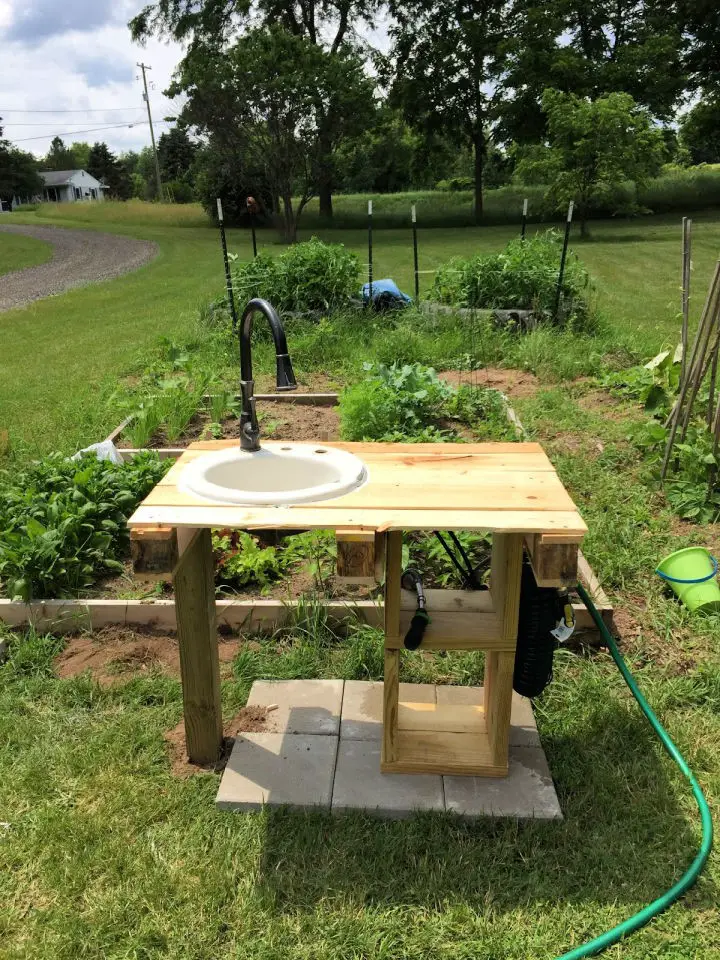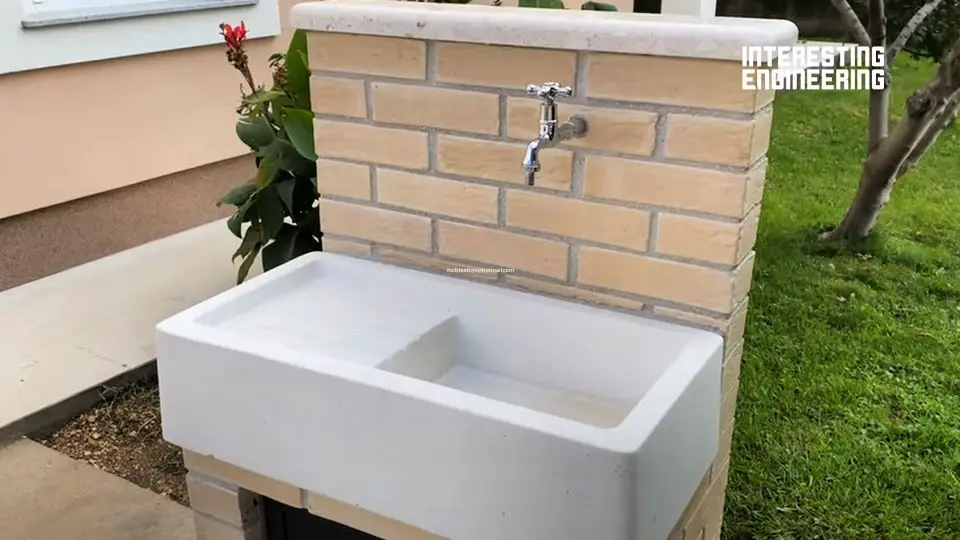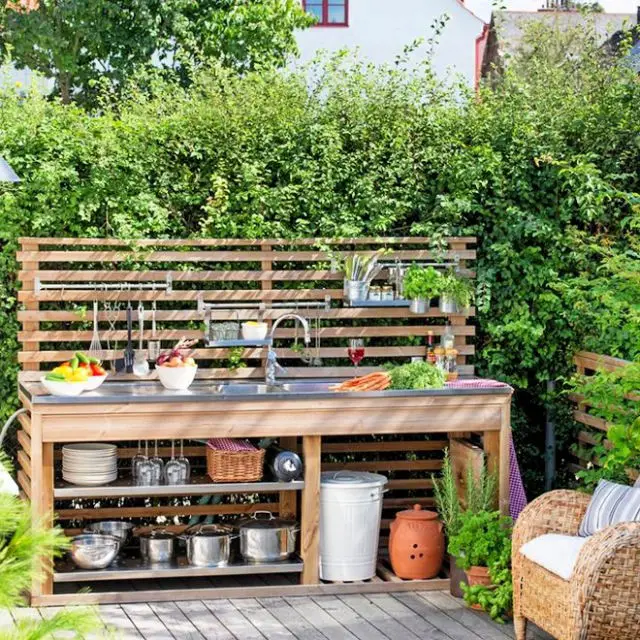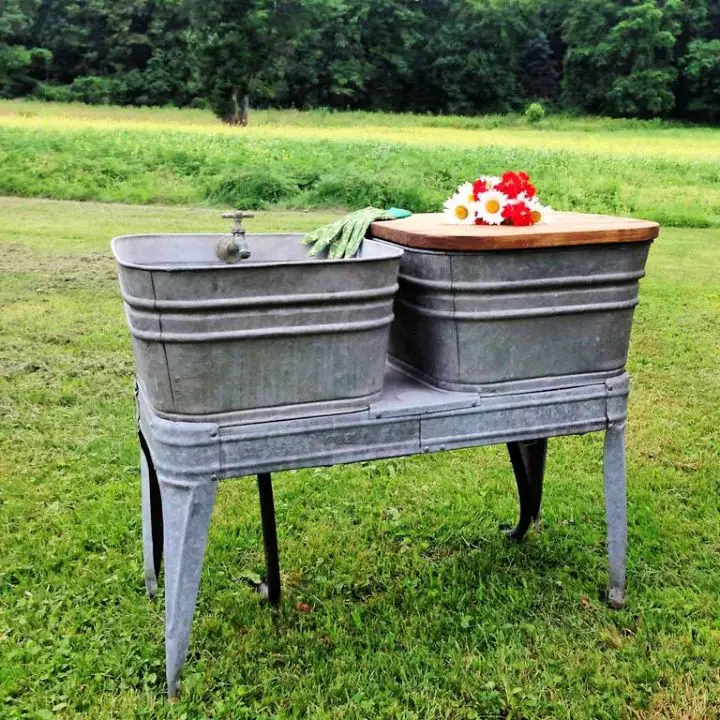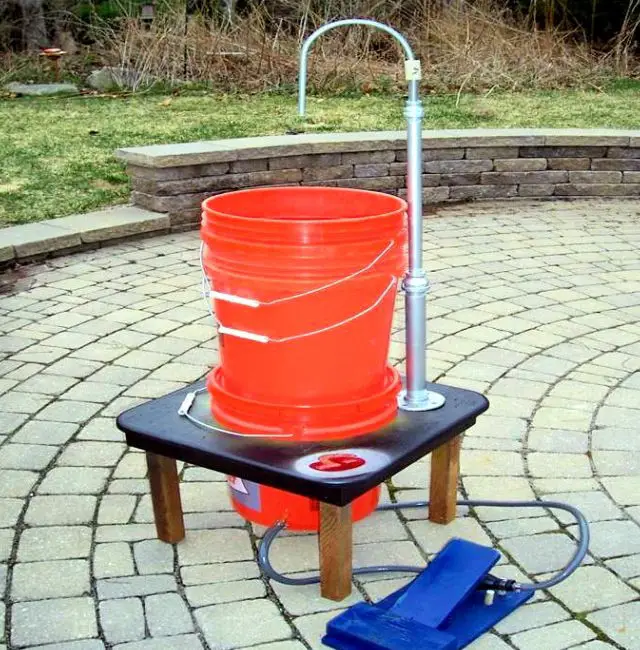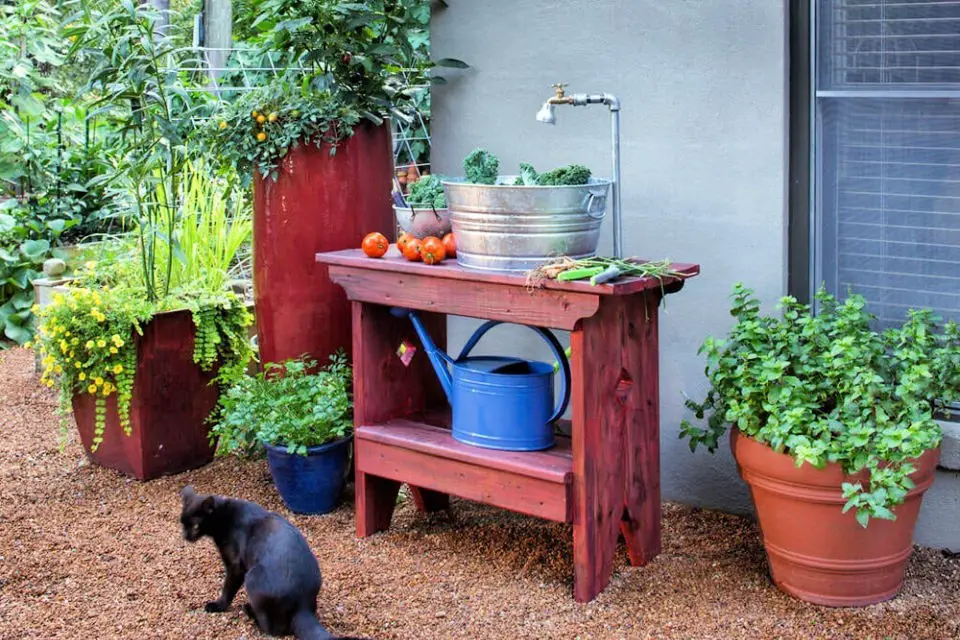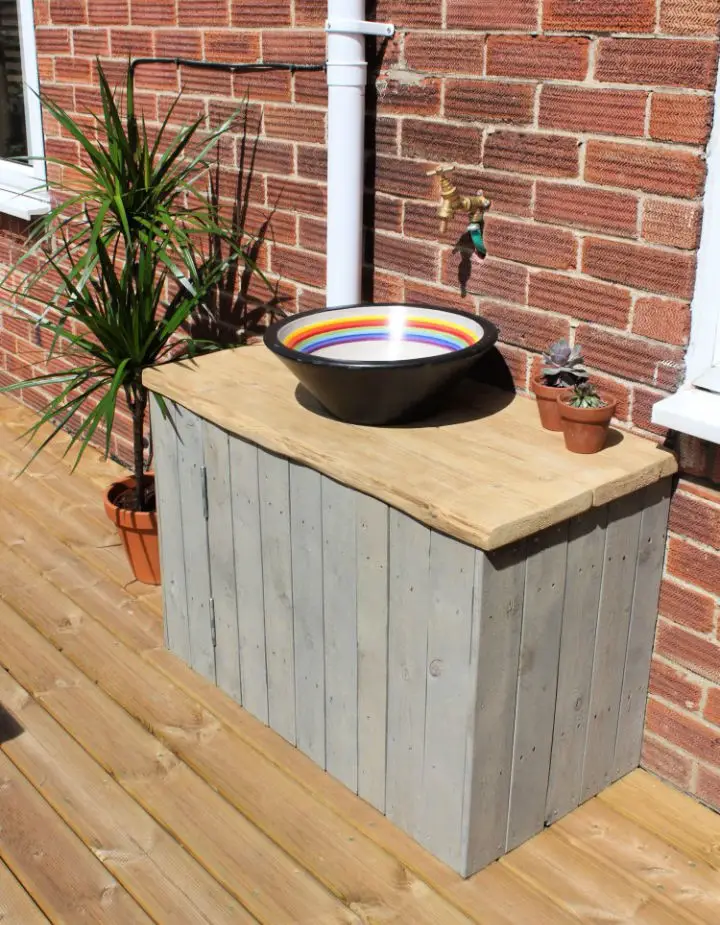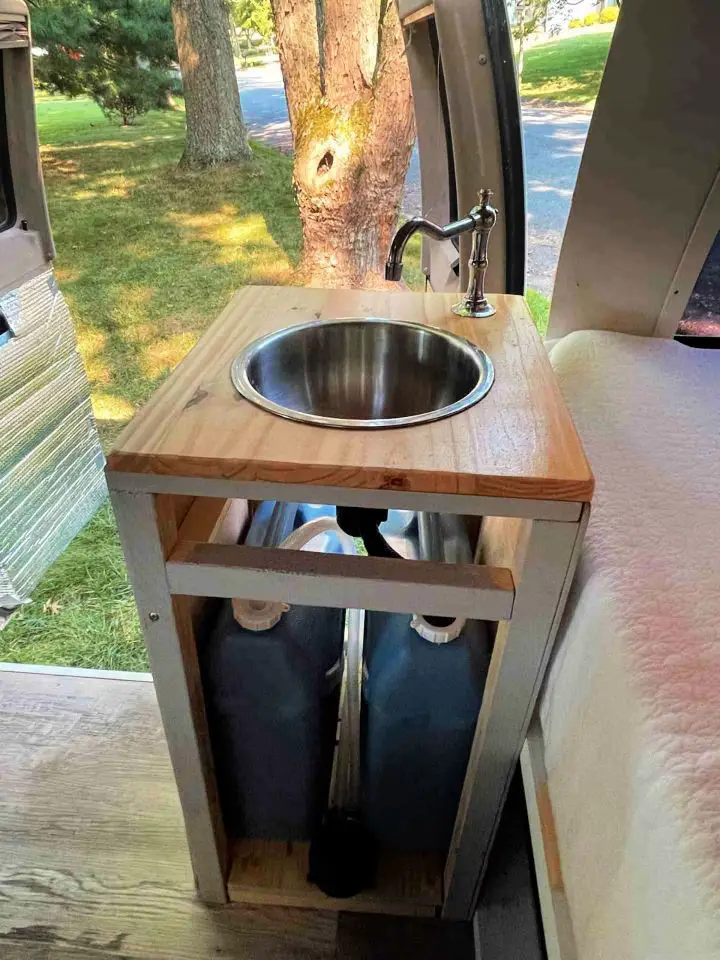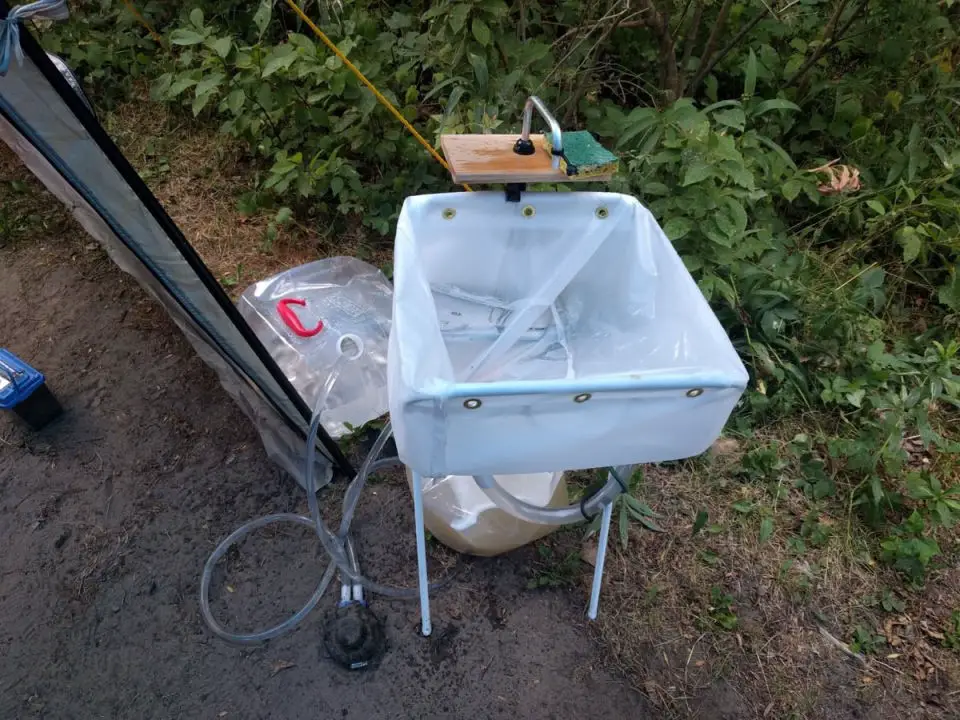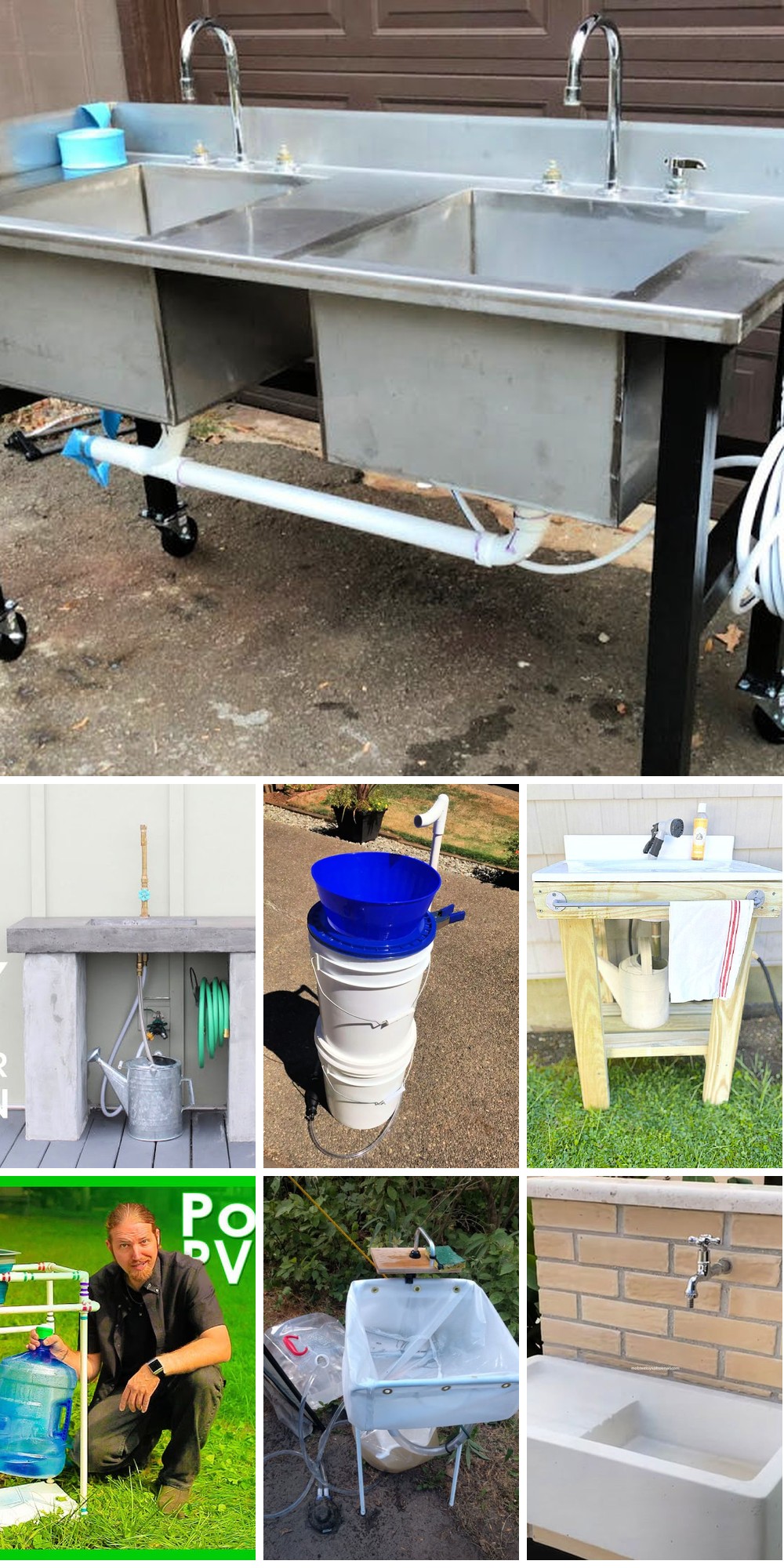
Whether you’re a gardening enthusiast or simply looking for a convenient spot to wash up after getting dirty, a DIY outdoor sink is an excellent addition to any backyard or garden. To help you get started, we’ve compiled 25 unique ideas that cater to various themes, materials, and needs. From rustic to modern, our customization options will guide you in creating the perfect outdoor sink tailored to your personal style. When it comes to building or maintaining your eco-friendly oasis, we’ll also share expert tips on water conservation, natural cleaning products, and creative ways to repurpose recycled materials. Dive into the world of DIY outdoor sinks and discover endless possibilities for transforming your outdoor space.
How to Make an Outdoor Sink – Step by Step Guide
Transforming your outdoor space with a DIY garden sink is an excellent way to add both charm and functionality. Whether you’re a gardening enthusiast or an artistic soul, this comprehensive guide will walk you through the process of building your own. Drawing inspiration from expert Karen Governale’s approach, we’ll take you step-by-step through the construction of a successful project that brings your vision to life.
Preparing for Your Project
Materials and Tools Needed:
The construction of a shed typically involves using a combination of materials, tools, and fixtures. For the frame, pressure-treated 1x4s provide a sturdy foundation, while the exterior is enhanced with primer, paint, and polyurethane for added protection and aesthetics. Galvanized metal is used for the roof and sides to ensure durability and resistance to corrosion. The lattice design adds an element of visual appeal, while motion sensor lights provide convenient illumination. Standard sink and plumbing fixtures are installed for functional purposes, and screws and nails are used to secure everything in place. On-site preparation involves the use of a drill and saw for cutting and shaping materials as needed. For finishing touches, paintbrushes and rollers are essential tools for applying coats of paint or polyurethane.
Step 1: Design Planning
When planning an outdoor sink installation, it’s crucial to decide on its size and location first. A good starting point is Karen Governale’s model, which measures 8 feet wide by 8 feet tall by 28 inches deep, offering ample space for various tasks. However, you should consider the available space in your garden or outdoor area and adjust the dimensions accordingly to ensure a comfortable and functional installation.
Step 2: Building the Frame
To create a robust foundation for your outdoor sink, begin by assembling a framework using pressure-treated 1×4 lumber. A crucial aspect of this process is ensuring that all joints and corners are precisely aligned and firmly secured with screws, as this structure will be exposed to the elements. The added stability provided by this attention to detail will help protect against weathering and wear.
Step 3: Add the Sink and Plumbing
To complete the installation process, begin by placing the sink within its designated frame, taking care to ensure it’s properly aligned and securely fastened to prevent any instability or damage. Next, attach the plumbing fixtures in accordance with local building codes and regulations. For added peace of mind and to minimize the risk of potential issues, consider hiring a professional plumber to inspect and verify your work.
Step 4: Applying Finishes
To ensure a durable and long-lasting finish for your outdoor sink, start by applying a primer to the wood frame. This provides a solid foundation for subsequent coats of paint. Next, apply two coats of weather-resistant paint, allowing each coat to fully dry before adding the next. For added protection against the elements, follow up with a coat of exterior polyurethane. When selecting colors, consider how they will complement your outdoor space and overall aesthetic. A thoughtful color choice can enhance the visual appeal of your design and create a cohesive look.
Step 5: Adding Details
To add a touch of elegance to your outdoor garden sink, consider wrapping lattice around its base. This decorative element will not only enhance the visual appeal but also provide a natural barrier against debris and pests. For added durability and protection from the elements, install a galvanized metal roof and sides that shelter your sink from rain and sun alike. By doing so, you’ll ensure your outdoor garden sink remains a functional and enjoyable feature for years to come. Finally, consider installing a motion sensor light nearby, which will not only provide necessary illumination at night but also boost the overall security of the area.
Step 6: Finalizing Your Project
Before considering your new outdoor sink a success, it’s crucial to thoroughly inspect its functionality. Ensure that water flows freely and drains effectively by conducting a series of tests. If any issues arise, make the required adjustments to the plumbing or structural components to guarantee optimal performance and efficiency.
Maintenance Tips
To maintain the health and appearance of your outdoor sink, it’s crucial to perform routine cleaning and maintenance tasks. A significant aspect of this process is ensuring that any built-up residue or debris is removed. This can be achieved through regular inspections and cleanings, which will not only improve the aesthetic appeal of your sink but also contribute to its overall longevity. Furthermore, applying a fresh coat of polyurethane annually is vital in protecting the wood from the harsh effects of the elements. By doing so, you’ll be able to preserve the integrity of your outdoor sink for years to come.
Video Tutorial
For a more hands-on approach to creating a DIY outdoor garden sink, we recommend following along with Karen Governale’s engaging video tutorial. This comprehensive visual guide provides an unparalleled level of understanding, as it showcases the process from start to finish, effortlessly aligning with this written tutorial to create a seamless learning experience.
Customization Ideas for Your DIY Outdoor Sink
Transforming your outdoor space with a bespoke DIY outdoor sink not only enhances its functionality but also injects a dash of personality. To help you bring your vision to life, here’s a starting point for crafting a sink that harmoniously blends form and function. Consider incorporating these thoughtful touches into your design to create a one-of-a-kind oasis.
Choose a Theme
To begin crafting an outdoor space that truly represents you, start by selecting a theme that harmonizes with your personality or complements the existing ambiance of your yard. This theme will serve as a foundation for making material and design decisions, ensuring a cohesive look that reflects your unique style.
Select Materials
When selecting materials for your outdoor project, prioritize durability and weather-resistance. High-quality options include stainless steel, natural stone, and treated wood. For a sustainable approach, consider incorporating recycled materials to minimize your environmental footprint.
Paint and Color
Transforming your outdoor space just got a whole lot easier! A fresh coat of paint on your sink can be a game-changer, and it’s all about making the right color choices. If you’re looking to add a bit of fun and personality to your outdoor area, bright colors can certainly do the trick. On the other hand, if you prefer a more subtle approach, neutral tones can help create a seamless blend between indoors and outdoors. Whatever your style, a well-chosen paint color can elevate your sink’s aesthetic and make it a focal point in your outdoor space.
Add a Backsplash
While functionality is inherent to a backsplash, it’s equally an invitation to express one’s creativity. Consider incorporating unconventional materials like mosaic tiles, pebbles, or sea glass into your design to create a truly distinctive look.
Incorporate Plants
Transforming your outdoor kitchen’s surroundings by incorporating lush greenery can have a profound impact on both aesthetics and functionality. By placing plants or herbs around your sink, you’ll create a visually appealing atmosphere that draws you in, making the space feel more inviting and enjoyable to spend time in. Moreover, having fresh herbs readily available near the cooking area eliminates the need for constant trips to the indoor garden or store-bought alternatives, allowing you to easily incorporate their flavors into your outdoor culinary creations.
Lighting
Effective illumination is crucial, and installing waterproof LED lights beneath the sink or along the edges can strike a perfect balance between form and function, casting a warm glow that elevates the overall aesthetic.
Accessories
When selecting accessories for your outdoor sink, prioritize functionality and aesthetics. Consider adding a soap dispenser or towel rack to enhance both form and function. Alternatively, hang utensils nearby to create a convenient and stylish setup. By embracing these practical suggestions, you can transform your outdoor sink into a reflection of your personal style, while maintaining simplicity and having fun with the process.
Troubleshooting Common Issues with DIY Outdoor Sinks
To ensure your DIY outdoor sink remains functional and clean, it’s crucial to anticipate and address potential problems proactively. By adopting a preventive maintenance approach, you’ll minimize the need for costly repairs or replacements down the line. Start by familiarizing yourself with common issues that can arise, such as mineral buildup, clogged drains, or rust development on exposed metal components. Regularly inspect your sink’s condition, addressing any concerns promptly to prevent minor problems from escalating into major headaches.
Clogs and Blockages
To minimize clog-related headaches, it’s essential to maintain a regular routine that keeps your sink’s plumbing system in top shape. This can be achieved by allowing water to flow freely through the sink on a weekly basis, essentially washing away any potential blockages before they have a chance to form. Additionally, it’s crucial to periodically clean out the drain to remove any debris or particles that may be lurking and waiting to cause issues. By taking these simple yet effective steps, you’ll significantly reduce the likelihood of clogs occurring in the first place.
Leaks
When it comes to addressing issues with your equipment, one common problem that may arise is the occurrence of leaks. These can manifest at connections or be caused by material wear and tear. To effectively resolve these leaks, there are a few straightforward steps you can take.
Firstly, inspect any connections to ensure they are properly secured. If necessary, utilize a wrench to tighten them further.
Additionally, it’s crucial to identify and replace any worn-out parts that may be contributing to the leak. By taking these proactive measures, you’ll be able to get your equipment up and running smoothly once again.
Weather Damage
When designing an outdoor sink, it’s crucial to prioritize protection from the harsh environment. A few key strategies can help ensure your sink remains functional and visually appealing for years to come. First and foremost, consider incorporating a covering or lid mechanism that can be easily deployed when the sink is not in use. This simple step will shield the sink from debris, dirt, and other contaminants that might otherwise accumulate and cause issues.Furthermore, selecting weather-resistant materials during construction is vital. Look for products that are specifically designed to withstand the elements, such as stainless steel, bronze, or high-quality ceramics. By taking these measures, you’ll be able to enjoy your outdoor sink without worrying about it succumbing to the rigors of Mother Nature.
Cost Analysis for Building a DIY Outdoor Sink
When it comes to building an outdoor sink, one of the most significant advantages is its potential for being a cost-effective solution. To provide some context, let’s break down the typical expenses involved in this project. Firstly, the price of materials will depend on the type and quality of items chosen. For instance, a pre-fabricated outdoor sink may be more affordable than building one from scratch using raw materials like copper or stone. Additionally, labor costs will also play a role, with DIY enthusiasts able to save money by taking on more of the workload themselves. On average, the total cost for an outdoor sink can range from a few hundred dollars to several thousand, depending on the scope and complexity of the project.
Materials
When it comes to upgrading your kitchen, the sink, faucet, and countertop are crucial components that can greatly impact the overall aesthetic and functionality. While there’s no one-size-fits-all solution, here are some key considerations for each of these elements. For sinks, you have a range of options at your disposal, from repurposing old containers to selecting store-bought models. The type of sink you choose will also influence your faucet selection, as you’ll want to ensure that the two complement each other seamlessly. In terms of countertops, durability is key. Materials like wood and stone offer a high level of resistance to scratches and stains, making them excellent choices for busy kitchens.
Tools
When it comes to tackling DIY projects or repairing everyday objects, having the right set of basic tools can make all the difference. Typically, a saw, drill, and wrench will cover most of your needs, providing a solid foundation for completing tasks efficiently.
Budget Tips
To keep costs low and maintain a well-functioning outdoor sink, consider using recycled materials whenever possible. Additionally, taking on the installation process yourself can help eliminate labor expenses. By being proactive in addressing any issues that arise and adopting a mindful approach to budgeting, you’ll be able to enjoy your outdoor sink without breaking the bank. Effective maintenance and budgeting are crucial components of a successful DIY project.
Eco-Friendly Options for Your DIY Outdoor Sink
When embarking on a DIY outdoor sink project, incorporating eco-friendly options not only benefits the environment but also yields cost savings over time. To achieve this, consider the following sustainable alternatives:
Use Recycled Materials
Think creatively when selecting a sink material – consider opting for recycled or reclaimed options to infuse your space with personality while minimizing waste. Vintage items like old barrels, repurposed pallets, or refurbished kitchen sinks can serve as unique and eco-friendly alternatives that tell a story and add depth to the room.
Water Conservation
To optimize your water usage, consider installing a faucet with an aerator that reduces the flow rate while maintaining pressure. Additionally, you can harness the power of rainwater by collecting it for use in your sink, effectively minimizing your reliance on municipal supplies.
Natural Cleaning Products
When it comes to keeping your home clean, you have a choice between opting for synthetic cleaning products and going the eco-friendly route. To make a positive impact on the environment, consider using natural alternatives like vinegar and baking soda as your go-to cleaning agents. These gentle yet effective options can help reduce your reliance on harsh chemicals that might harm the planet.
Solar-Powered Faucet
For the environmentally conscious homeowner, incorporating eco-friendly features into an outdoor sink can be a great way to make a positive impact on the planet. One innovative option is installing a solar-powered faucet, which not only reduces energy consumption but also provides a functional and sustainable solution for outdoor water use.
Maintenance Tips for Your DIY Outdoor Sink
To prevent issues and maintain the functionality of your outdoor sink, regular upkeep is essential. By following these guidelines, you can keep your sink in top shape:
Regular Cleaning
Maintaining a sparkling sink is as easy as following a simple routine. Start by washing it with a gentle soap and warm water, making sure to avoid any harsh chemicals that could potentially scratch or damage the surface. Consistency is key when it comes to keeping your sink looking its best.
Drain Care
To minimize the likelihood of clogs forming, it’s essential to regularly remove any debris that may have accumulated in your drains. This can be done by performing a simple maintenance task. If an unexpected blockage does arise, don’t worry – you’re equipped with two effective tools to tackle the issue. The first is a trusty plunger, which can often provide a quick and easy solution. Alternatively, if the clog is more stubborn, a plumber’s snake can be used to carefully dislodge any obstructing materials.
Winterizing
To mitigate the effects of harsh winters on your plumbing system, take proactive measures to winterize your sink if you reside in an area with frigid temperatures. This involves thoroughly draining any remaining water from the pipes and surrounding areas, followed by effective insulation to safeguard against potential freezing. By doing so, you’ll be able to enjoy a worry-free winter season, free from concerns about burst pipes and costly repairs.
Check for Leaks
Regularly inspecting your outdoor sink is crucial to ensure it remains in good working condition. This involves checking for any signs of leaks or damage that could lead to water waste and costly repairs down the line. By addressing these issues promptly, you’ll not only conserve water but also prevent potential water damage to surrounding surfaces.
FAQs About DIY Outdoor Sinks
Get the inside scoop on creating a DIY outdoor sink that’s perfect for your backyard retreat. This exhaustive FAQ will walk you through the process of bringing your outdoor vision to life, so you can start enjoying your personal haven sooner.
What materials are best for a DIY outdoor sink?
When it comes to constructing an outdoor sink, durability and weather-resistance are crucial considerations. To achieve this, opt for materials that can withstand the elements such as stainless steel, stone, or treated wood. Additionally, recycled materials offer a sustainable and eco-friendly alternative, providing a guilt-free solution for your outdoor space.
How do I ensure my outdoor sink is eco-friendly?
To build an eco-friendly home, start by embracing sustainability in your construction choices. Consider repurposing reclaimed materials to reduce waste and minimize the environmental impact of your building project. Next, optimize water usage by installing low-flow faucets that conserve this precious resource. Additionally, explore alternative energy sources like solar power for any electrical needs. Finally, prioritize natural cleaning products when maintaining your sink and other surfaces, choosing eco-friendly options that align with your commitment to a sustainable lifestyle.
Can I connect my outdoor sink to my home’s plumbing?
While it’s technically possible to connect an outdoor sink to your home’s plumbing system, doing so often necessitates the expertise of a professional to guarantee a seamless and compliant installation that adheres to relevant local regulations.
How do I maintain my outdoor sink?
To ensure your outdoor sink remains in good condition, it’s essential to incorporate routine maintenance into your schedule. A combination of regular cleaning using mild soap, diligent leak checking, and winterization efforts – particularly if you reside in a cold climate – can go a long way in preserving the integrity of your exterior sink. By implementing these measures, you’ll be able to extend its lifespan and prevent costly repairs down the line.
What is the best way to prevent clogs in an outdoor sink?
To maintain your sink’s optimal performance, ensure you consistently clear out any debris that accumulates in the drain. This can be achieved by simply running warm water through the sink after each use. However, if you encounter more stubborn blockages, it may be necessary to employ a plunger or plumber’s snake to effectively dislodge the clog.
How can I add a personal touch to my outdoor sink?
Transform your sink into a reflection of yourself by infusing it with personal touches. Start by giving it a fresh coat of paint to match your unique aesthetic. Alternatively, create a stunning focal point with a creative backsplash that complements the surrounding space and reflects your personality. Don’t forget to bring in some greenery or incorporate accessories that add a touch of whimsy and make the sink truly yours.
Is it possible to build a mobile outdoor sink?
Elevate your outdoor experiences with a portable and versatile mobile outdoor sink! By attaching wheels to its base, this innovative fixture enables effortless repositioning around your property, catering to changing demands and preferences.
What should I consider when choosing a faucet for my outdoor sink?
When choosing an outdoor faucet, carefully consider the dimensions of your sink, the specific tasks you’ll need to accomplish, and the aesthetic goals for your outdoor area. The size and shape of your sink, as well as the types of activities you’ll be doing, such as washing dishes or watering plants, should influence your decision. Additionally, think about how the faucet will visually integrate with your outdoor space – its design, color, and style should all be taken into account to ensure a cohesive look.
How do I protect my outdoor sink from the elements?
To safeguard your outdoor living space against the elements, opt for weather-resistant materials that can withstand rain and sunlight. When not in use, ensure the sink is properly covered to prevent water accumulation and subsequent damage. Furthermore, apply protective coatings to wood surfaces to shield them from harm caused by UV rays and moisture.
Can I build an outdoor sink on a budget?
To create an outdoor sink on a budget, start by seeking out affordable materials and repurposing items you already own. Consider taking on the installation yourself to further reduce costs. By addressing these frequently asked questions, you’ll be well-equipped to build a functional and stylish outdoor sink that suits your needs and elevates your outdoor living space.
25 DIY Outdoor Sink Ideas
Transform your backyard or yard into a haven of functionality and style by creating an outdoor sink space that meets both gardening and utility needs. To inspire you, we’ve gathered 25 innovative DIY projects that showcase creative ways to design and build an outdoor sink that’s not only practical but also visually appealing.
DIY Farmhouse Style Outdoor Sink
Elevate the functionality and charm of your outdoor space by building a rustic farmhouse-style DIY sink. This versatile station is perfect for washing garden produce, watering plants, or cleaning up after outdoor projects, making it an essential addition to any backyard.
This step-by-step guide will walk you through the process of creating this practical masterpiece using salvaged cast iron sinks, pressure-treated 2X4 boards, and a Wagner FLEXiO 4000 Paint Sprayer. You’ll learn how to connect your sink to an outdoor water supply, adding convenience and functionality to your outdoor retreat.
This project seamlessly blends style and utility, proving that procrastination doesn’t always pay off. By incorporating this attractive and practical piece into your outdoor space, you’ll be rewarded with a beautiful and functional area perfect for relaxation or entertaining.
How to Make an Outdoor Camp Sink
Transform your outdoor escapades by creating a temporary hand washing station, a DIY project that’s perfect for camping trips, aid stations, areas without running water, or temporary work sites. This ingenious system utilizes a two-bucket mechanism, where clean water from the bottom bucket is pumped into a wash basin via a manual foot-activated faucet. The used water then flows into the top bucket, completing an effective sanitation cycle.
Assembling or disassembling this unit is a snap, and all components nest neatly within the buckets for effortless transport. With an estimated cost of $25, you’ll need items like two 5-gallon buckets, a bulb siphon, a vinyl hose, lids, a popcorn bowl, PVC pipes, elbows, and a quick-grip clamp. Experience improved hygiene on-the-go with this innovative hand washing station.
Rustic DIY Wine Barrel Outdoor Sink
Transform an old wine barrel into a rustic outdoor sink by combining unique materials with straightforward DIY steps. Start by locating a 55-gallon oak barrel and preserving its historical character, then secure the wood staves and assemble the door to create a functional piece that adds individuality to your outdoor space. This project not only showcases creativity but also promotes sustainability and recycling, making it a charming addition that serves both form and function.
Homemade Outdoor Camping Sink Using Plastic Shelf
Leave behind the hassle of camping dish duties with a DIY portable sink that’s as easy to use as it is convenient. This ingenious gadget simplifies outdoor meal prep by providing a lightweight, foldable, and natural drying rack all in one. By repurposing a small metal sink or plastic dishpan, a plastic shelving unit, a faucet supply line, and other supplies, you can create an outdoor sink that elevates your camping experience, transforming it into a more enjoyable and less chore-filled adventure.
How to Build an Outdoor Small Sink
Transform your backyard into a functional oasis by creating a DIY outdoor sink that seamlessly connects to a water spigot. Constructed from durable materials like treated lumber or cedar, this sink exudes a professional aura, elevating the ambiance of your outdoor space. The project requires meticulous planning and execution, involving the fabrication of legs, stretchers, decking boards, shelves, and top frames. Once assembled, install the sink and faucet to create a practical and visually appealing focal point. To ensure longevity, carefully apply weather-resistant glue and screws, utilize pocket hole drilling techniques, and seal all joints with silicone. Moreover, consider the sink’s dimensions, which are dependent on the size of the rough opening. By following these guidelines, you’ll be able to build a functional and charming outdoor sink that simplifies cleanups during backyard gatherings or gardening sessions. This project not only enhances your backyard’s functionality but also adds a touch of charm to your home.
Making Your Own Outdoor Sink for the Garden
Transform your backyard into an oasis by incorporating a DIY outdoor sink station with a personal touch. What was once a mere renovation leftover has evolved into a practical solution for watering plants, rinsing fresh produce, and streamlining everyday gardening tasks.
The base of this innovative fixture is constructed from repurposed 2×6 lumber and a sturdy 4×4 post, providing stability and longevity. The clever design ensures that the sink remains securely in place, ready to serve its purpose.
To further enhance functionality, the outdoor sink station features a quick-release hose and a three-way connector, making it easy to attach or detach as needed. This thoughtful and creative approach to recycling renovation materials results in a valuable outdoor asset that adds a touch of personality to your garden space.
Build Your Own Outdoor Sink Unit
Transform your outdoor space into a serene oasis by crafting a bespoke DIY sink unit. This step-by-step guide assumes you’ve already established the necessary plumbing and drainage infrastructure. To begin, gather your arsenal of materials, including cement mix, a plastic bucket, putty knife, bricks or cinder blocks, spirit level, rubber mallet, porcelain sink unit, marble plinth, baseboards, faucet, brick sealant, welding gear, safety equipment, and power drill.
Start by preparing the cement according to the manufacturer’s instructions. Next, using a trowel, spread the mixture evenly across the designated area for your sink, taking care to apply the correct amount based on your design vision. With each stroke, envision the enhanced usability and charm this feature will bring to your garden.
Embark on this creative journey and unlock the beauty of DIY, allowing you to craft a unique outdoor space that reflects your personal style.
Best DIY Outdoor Kitchen Sink From Wood
Transform your patio into an ultimate outdoor kitchen with inspiring sink ideas that harmoniously blend functionality and visual appeal. Imagine enjoying al fresco culinary experiences without the need to venture indoors for dishwashing or supply retrieval. With a DIY sink at its core, this open-air setup seamlessly integrates cooking, storage, and socializing areas. The design is built to withstand the elements using weather-resistant materials like pressure-impregnated wood, ensuring durability and longevity. A standout feature is the innovative grey water filtration system, ‘Stenkista,’ which cleverly repurposes used water, making this outdoor kitchen a sustainable and eco-friendly addition to your property. Follow the step-by-step instructions to bring this lively dining area to life and create an unforgettable space for food, drink, and conversation.
DIY Washed Up Outdoor Sink with Water Hose
Transform your outdoor space into a haven of convenience and style by crafting a DIY outdoor sink. This versatile feature is perfect for post-gardening cleanups, backyard BBQs, or barn visits. To create this multipurpose gem, you’ll need the following materials: wall-mount faucet, thread tape, elbow pipe, straight pipe, brass garden hose adapter, deck boards, 2-by-2 board, screws, and basic tools like a drill, wrench, and circular saw.
The creation process involves three key steps:
Drill a hole for the faucet, ensuring a secure and watertight fit. This will provide easy access to water for cleaning up after gardening or other outdoor activities.
Create a garden hose attachment by combining the elbow pipe, straight pipe, thread tape, and brass adapter. This attachment will allow you to connect your outdoor sink to an external water source, making it even more practical.
Craft a functional lid for the washtub using vintage boards and screws. This lid will not only add a touch of rustic charm to your outdoor space but also provide a convenient way to cover and protect the sink when not in use.
With these straightforward steps, you can enjoy unlimited uses for this outdoor sink, emphasizing both utility and creativity in your outdoor areas with this innovative project.
Handmade DIY Outdoor Field Sink
Imagine having access to running water at remote locations without relying on conventional plumbing systems. The DIY wash station powered by a foot pump offers a innovative solution for camp cookouts, backyard gatherings, and even food preparation in remote areas. This ingenious contraption not only provides a convenient way to keep hands clean but also promotes safe food handling practices and conserves water. Unlike traditional spigots that require touching with dirty hands, this station’s on-demand pump system eliminates the need for contact, making it a hygienic choice for any outdoor setting.
The foot-powered pump transfers clean water from a lower bucket to a spout for hand washing, while collecting used water in a separate gray water bucket. This novel washing station is perfect for any outdoor occasion, making hand cleanliness easily accessible and fun!
How to Build an Outdoor Sink
Transform your outdoor space into a haven of functionality and sustainability by building a DIY outdoor sink. This innovative fixture offers a convenient way to rinse vegetables, fill vases, or tend to plants without having to venture indoors. The sink’s foundation is built around a sturdy two-tier wooden stand crafted from pressure-treated pine lumber, providing ample support for the galvanized pipe faucet and spray nozzle that sit neatly on one side. A galvanized tub serves as both sink and open tabletop area, allowing you to multitask with ease.
The water supply system is designed to be flexible, allowing you to tap into an interior line or use a potable water hose from an exterior spigot. This means you can place your sink in any location that suits your needs best. A custom- made drainage system takes the sink water and redirects it towards watering plants, making this outdoor sink an eco-friendly addition to any garden.
What’s more, the materials used to build this DIY outdoor sink are readily available at home improvement stores, making it a budget-friendly option that’s both versatile and environmentally friendly. With this project, you can create a space that’s not only functional but also sustainable, and we encourage you to get creative and start building your own outdoor sink today.
Making a Garden Wash Basin Out of Pallets
Transform your outdoor space with a one-of-a-kind DIY garden wash basin crafted from repurposed pallets. This eco-friendly project requires minimal tools, including a pry bar, hammer, screw gun, and various saws. You’ll also need screws of different sizes, a sander, sealer, and paint thinner. Start by designing your unique wooden basin stand to fit your preferred dimensions, then build the structure using randomly arranged pallet boards for an earthy aesthetic. Next, create a recessed area for your chosen sink or basin, adding a touch of customization to this upcycled masterpiece. With its layered design and rustic charm, this garden wash basin is a testament to the beauty of sustainability and creativity. You can find sinks at local yard sales or home stores to further customize your project.
How to Install an Outdoor Kitchen
Transform your outdoor space into an alfresco dining and cooking haven by repurposing pallets, scaffold boards, and a ceramic sink. This eco-friendly project breathes new life into scrap wood, combining functionality with visual flair courtesy of a vibrant ceramic basin. The resulting outdoor kitchen not only provides ample storage for garden essentials but also boasts a convenient outdoor sink, elevating your backyard’s aesthetic appeal. Embark on this creative DIY journey and inject some personality into your garden today.
DIY Outdoor Sink Made With Cinder Blocks
Transform your outdoor space with a clever DIY project that combines functionality with sustainability. By repurposing cinder blocks, a stainless steel sink, and a wooden pallet, you can create an affordable and practical outdoor sink for washing gardening tools, flower pots, and fresh produce without having to venture indoors. The versatility of this setup allows you to customize the height of the sink base using the easy-to-assemble cinder block structure.
The wooden pallet at the back provides a convenient space for hanging tools, making it easy to keep your outdoor workspace organized. To ensure a reliable water supply, attach a garden hose to a frost-free hydrant and adjust the drain pipes to catch water in buckets below – perfect for reuse or disposal.
This DIY sink is not just functional, but also offers an opportunity to express your creativity through painting and decoration. With minimal investment, you can optimize your outdoor chores and enhance your garden’s aesthetic appeal.
DIY Foot Pump Sink on a Budget
Transforming your van adventures into a seamless experience is now possible with a simple and cost-effective DIY sink. This game-changing guide takes you through the process of creating a functional sink system, leveraging basic materials like a sink strainer, foot pump, vinyl tubing, camper drain, 6-gallon tanks, faucet, and metal bowl. The result is a convenient water source that seamlessly integrates into your van’s design, making it easy to access and dispose of greywater. By positioning the sink near the door, you’ll enjoy effortless waste disposal. This affordable and straightforward approach elevates your van experience to new heights, ensuring maximum comfort during your trips.
Outdoor Kitchen Sink Woodworking Plan
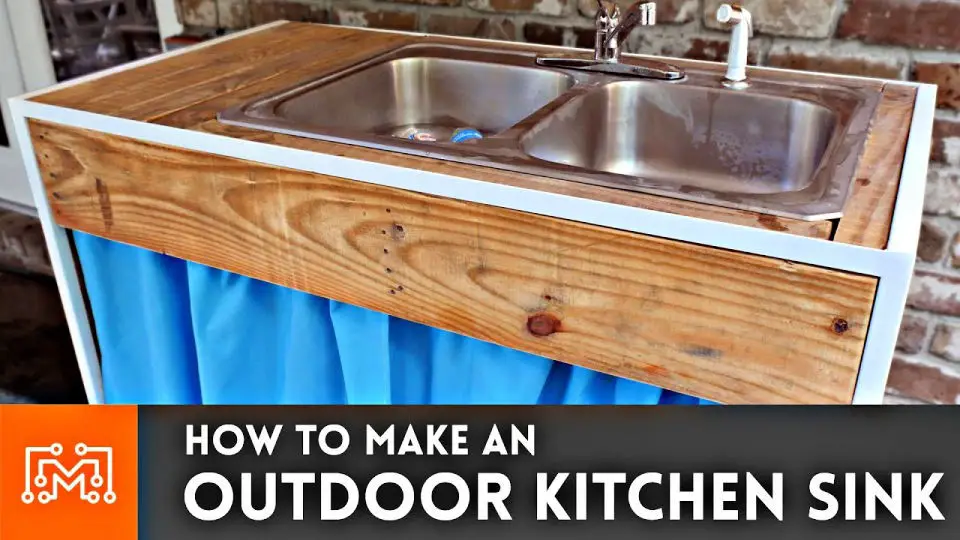
Transform your outdoor cooking experience by creating a one-of-a-kind DIY kitchen sink that seamlessly integrates woodworking, metalworking, and sewing techniques. This multifaceted project requires precision and attention to detail as you work with various materials like angle grinders, metal cutting bandsaws, singer sewing machines, and tension rods. The end result is a functional and visually appealing sink that elevates the convenience and enjoyment of outdoor cooking, while also serving as a testament to your creative problem-solving skills, perseverance, and craftsmanship. This innovative project showcases the versatility of DIY endeavors, combining different domains to produce something truly unique and practical. By embarking on this journey, you’ll not only acquire new skills but also experience the satisfaction that comes from self-sufficiency and inventive ingenuity.
How to Make an Outdoor Utility Sink

To elevate your gardening routine, consider installing a DIY outdoor utility sink as part of your vegetable wash station. This comprehensive guide will walk you through the process of designing a plumbing system, implementing irrigation techniques, and mounting the sink to brick walls, including the challenge of drilling into brick. The featured project utilizes a Mustee utility sink/tub and a DIG irrigation system, both readily available at Home Depot. By building a user-friendly garden wash station, you’ll be able to extend the lifespan of your produce and enjoy a more streamlined gardening experience.
Easy DIY Outdoor Kitchen Sink
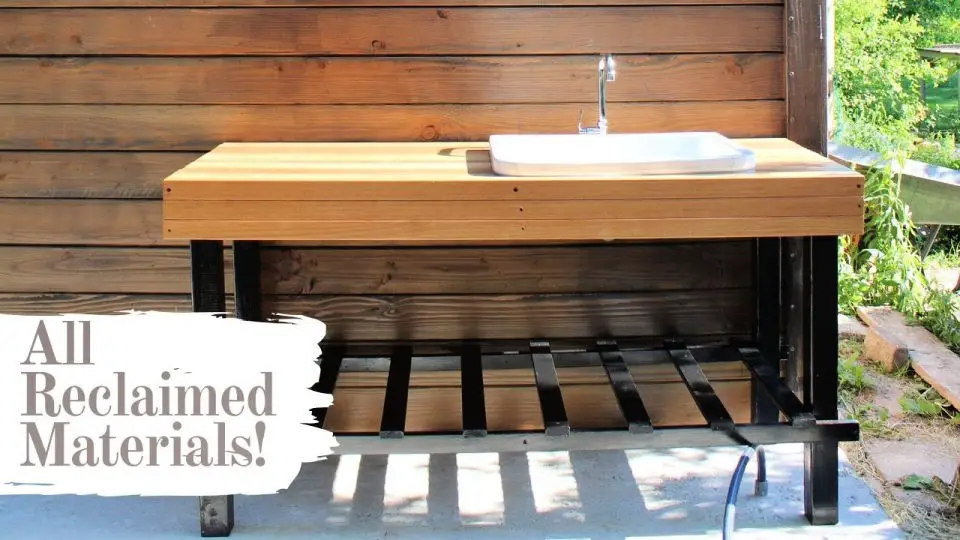
Transform your outdoor space into a functional and eco-friendly oasis by upcycling discarded materials into a unique kitchen sink. This budget-friendly DIY project is perfect for tiny house enthusiasts, requiring only old bed slats, a salvaged sink, and some reclaimed wood. By combining these elements, you’ll create a sturdy base and an attractive countertop, enhanced with wooden plugs and a touch of black paint. To elevate the design further, add a storage rack and finish it off with a durable lacquer coating. The result is a beautiful and practical addition to your outdoor area that showcases your commitment to sustainability and resourcefulness in home improvement projects.
Portable DIY Patio Sink on Budget
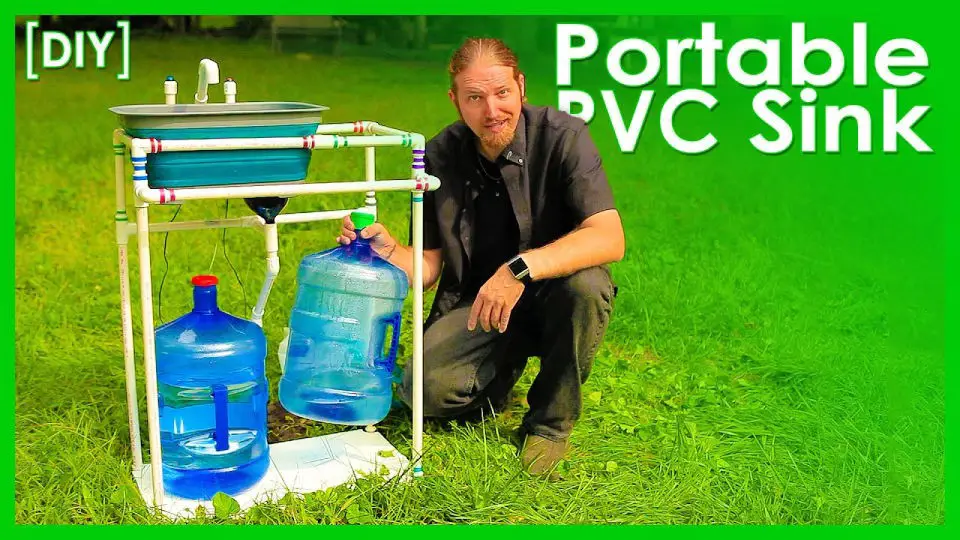
Imagine having a fully functional kitchen sink by your side, no matter where your travels take you. This innovative DIY project makes that possible with the creation of a portable PVC sink. By combining a PVC frame and collapsible drying rack, you’ll have a convenient and practical solution for washing up on-the-go. But that’s not all – this portable sink takes it to the next level by incorporating water-cooler jugs and electric water pumps, providing a complete sink experience. The best part? You can customize your setup with push-button faucets or rotary switches, adding an extra layer of realism. To bring this project to life, you’ll need materials like 1/2-inch schedule 40 PVC pipe, PVC tee connectors, 90-degree elbows, 45-degree elbows, waterproof momentary push buttons, and JST connectors. With this portable sink, you can enjoy the comfort of home wherever your travels take you.
How To Make an Outdoor Garden Sink

Elevate your outdoor space by introducing a functional and visually appealing DIY outdoor sink that caters to various activities. For garden enthusiasts, consider a potting station featuring a sink that doubles as a planter or irrigation hub. Grill masters can appreciate a convenient wash station with a built-in sink and storage for utensils.To create a robust and weather-resistant structure, use pressure-treated 1x4s to build the base of your outdoor sink, measuring 8′ wide x 8′ tall x 28″ deep. Add an extra layer of durability with a primer, two coats of paint, and exterior polyurethane coating. A galvanized metal roof and sides provide added robustness.To enhance usability, integrate a motion sensor light that illuminates the area at night, making it perfect for nighttime gardening or studio work. With this personalized guide, you can customize your outdoor sink to meet the unique needs of your art studio, shed, or backyard oasis.
DIY Concrete Countertops and Sink
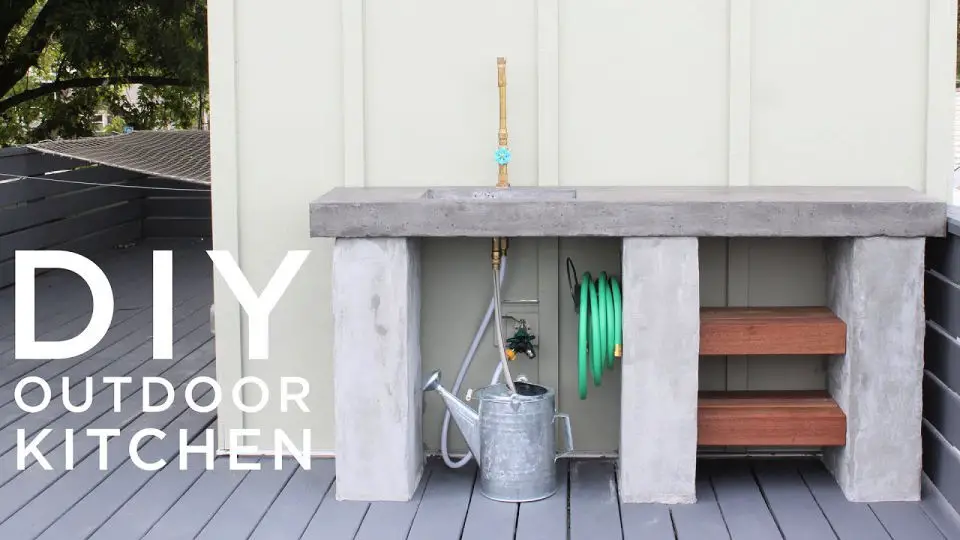
Transforming your outdoor space into an inviting haven is achievable with a DIY kitchen boasting durable concrete countertops and a functional sink. This detailed guide breaks down the process into manageable steps, making it easy to build this impressive addition to your backyard. The comprehensive instructions cover every aspect of construction and finishing touches, ensuring a seamless execution.
With the right materials and supplies in hand, you’ll be equipped to embark on this creative project. From preparation to completion, the walkthrough provides clarity on each step, allowing you to craft a practical and stylish outdoor kitchen that elevates your outdoor entertainment experience.
Best of all, this remarkable project won’t put a dent in your budget, providing an affordable way to enjoy the benefits and functionality of a DIY kitchen in the comfort of your own backyard.
Outdoor Produce Sink Idea
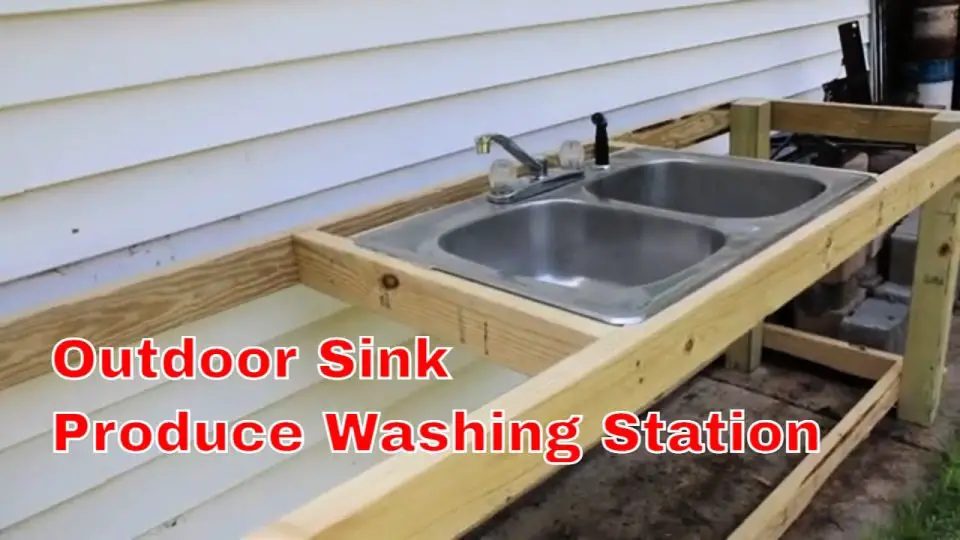
If you’re seeking a hands-on addition to your garden, consider constructing a DIY outdoor sink and wash station. This practical project combines treated lumber for the frame, hardware cloth for a drying rack, and an affordable stainless steel sink with a faucet and sprayer. To bring this idea to life, gather materials such as treated lumber in various dimensions, outdoor treated screws, and stainless steel screws.
When it comes to plumbing, you’ll need braided stainless steel flexible faucet supply lines, adapter fittings, and a rubber washing machine connector. By creating an outdoor sink, you’ll have the convenience of washing and preparing your garden produce immediately, eliminating the need for dirty veggies to make their way inside.
This functional piece not only enhances your outdoor space but also provides a valuable utility. As a budget-friendly and enjoyable project, it’s well worth the effort in improving your gardening efficiency. Start working on this worthwhile project today and experience the benefits of having an outdoor sink in your garden!
Simple DIY Sink for Backyard
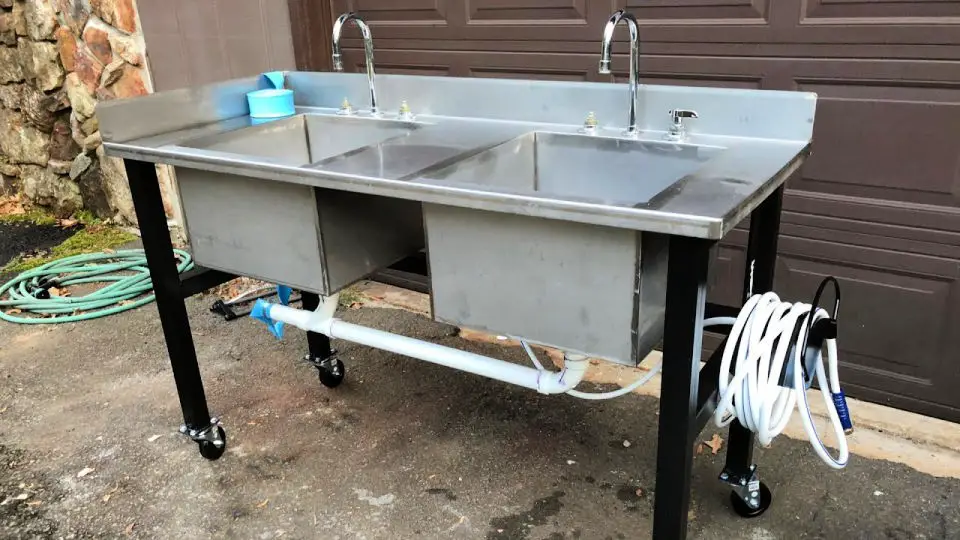
Transform your backyard into an efficient outdoor oasis by creating a one-of-a-kind homemade sink that seamlessly blends with your unique aesthetic. From rustic stone basins to sleek stainless steel units, explore the endless possibilities of DIY outdoor sinks and learn how to build a practical setup for efficiently cleaning vegetables and brewing beer. This versatile project features a repurposed stainless steel sink mounted on a custom-built rolling stand with four swivel casters, providing effortless mobility wherever you need it. A step-by-step guide will walk you through the process of plumbing the cold water side and effectively draining using a collapsible swimming pool hose. As you enhance your outdoor workspace with this project, enjoy the numerous benefits of having a functional and convenient outdoor sink at your disposal.
Cute Little Outdoor Sink Ideas
Unleash the joy of gardening and add a touch of whimsy to your backyard with a DIY outdoor sink that’s both functional and budget-friendly! By repurposing a reclaimed bathroom sink, pressure-treated wood, and basic plumbing fittings, you can create a sturdy and convenient outdoor sink that will make cleaning up a breeze. Follow this step-by-step guide as we walk you through assembling the sink, attaching legs, adding a shelf, and connecting the water source using a hose splitter. With this practical and easy-to-follow tutorial, you’ll have a fully functional outdoor sink in no time, perfect for quickly rinsing off your hands or garden tools. Get creative and bring some homeroad charm to your outdoor space with this fun and easy DIY project!
DIY Camp Sink With Jäll Laundry Bag
Transform your campsite into a cozy retreat by crafting a portable camp sink using the versatile IKEA JÄLL laundry bag. This DIY project is like having a mini laundry room on the go, providing a convenient and functional outdoor sink solution for camping enthusiasts. By following this step-by-step guide, you’ll learn how to modify the laundry bag to achieve the perfect sink depth, source a suitable spout and drain, and power the water flow with a marine foot pump. With its unique design and ease of assembly, this project is perfect for those seeking to bring a touch of home to their camping adventures.
Conclusion:
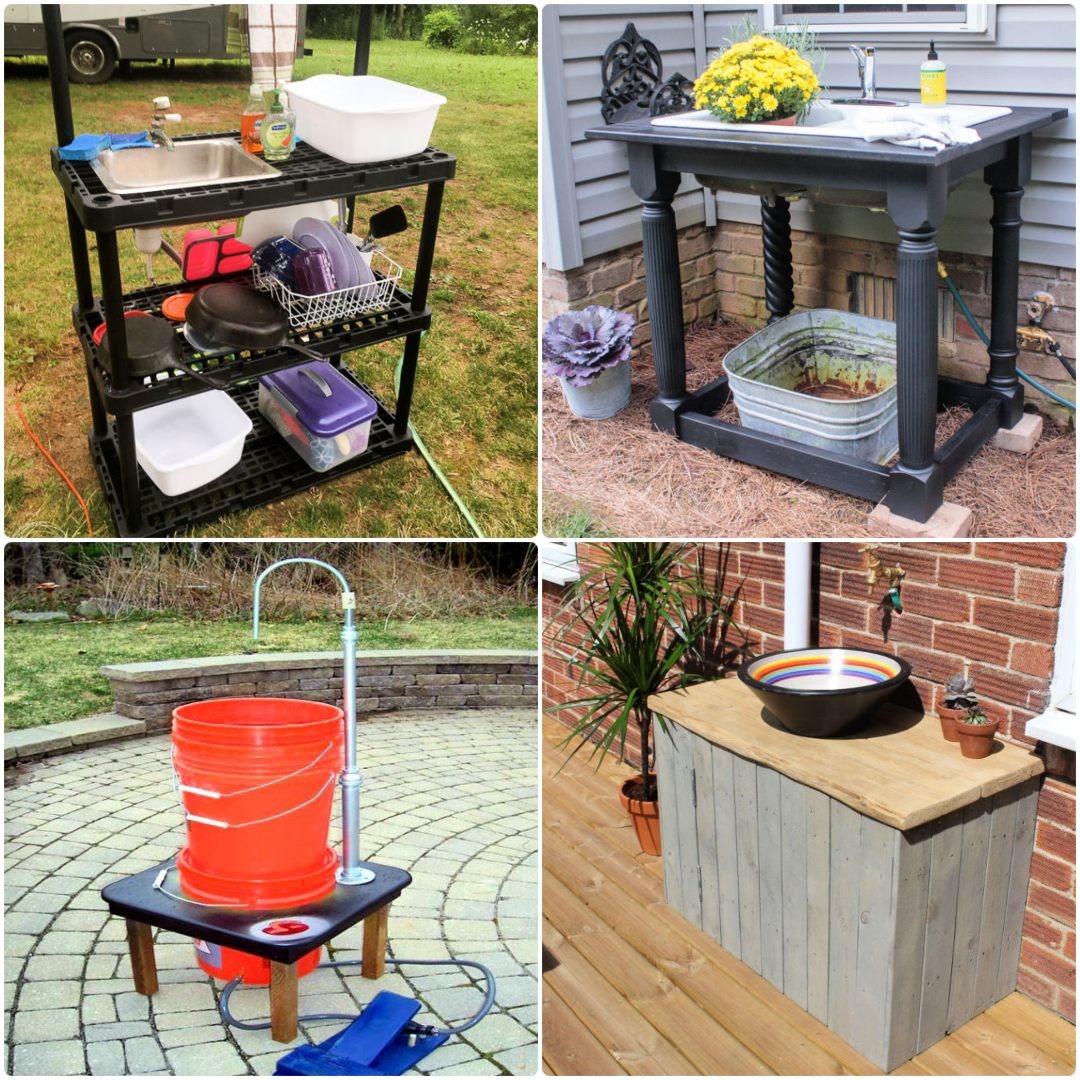
To recap, these 25 DIY outdoor sink concepts encompass a wide range of customization opportunities, from overcoming common challenges to eco-friendly solutions and cost-effective strategies. By tailoring your design with personalized themes, materials, and accessories, you can create an outdoor sink that not only serves its purpose but also reflects your unique style. Whether it’s choosing the perfect faucet or preparing for winterization, these ideas provide a comprehensive guide to help ensure the success of your outdoor sink project.




